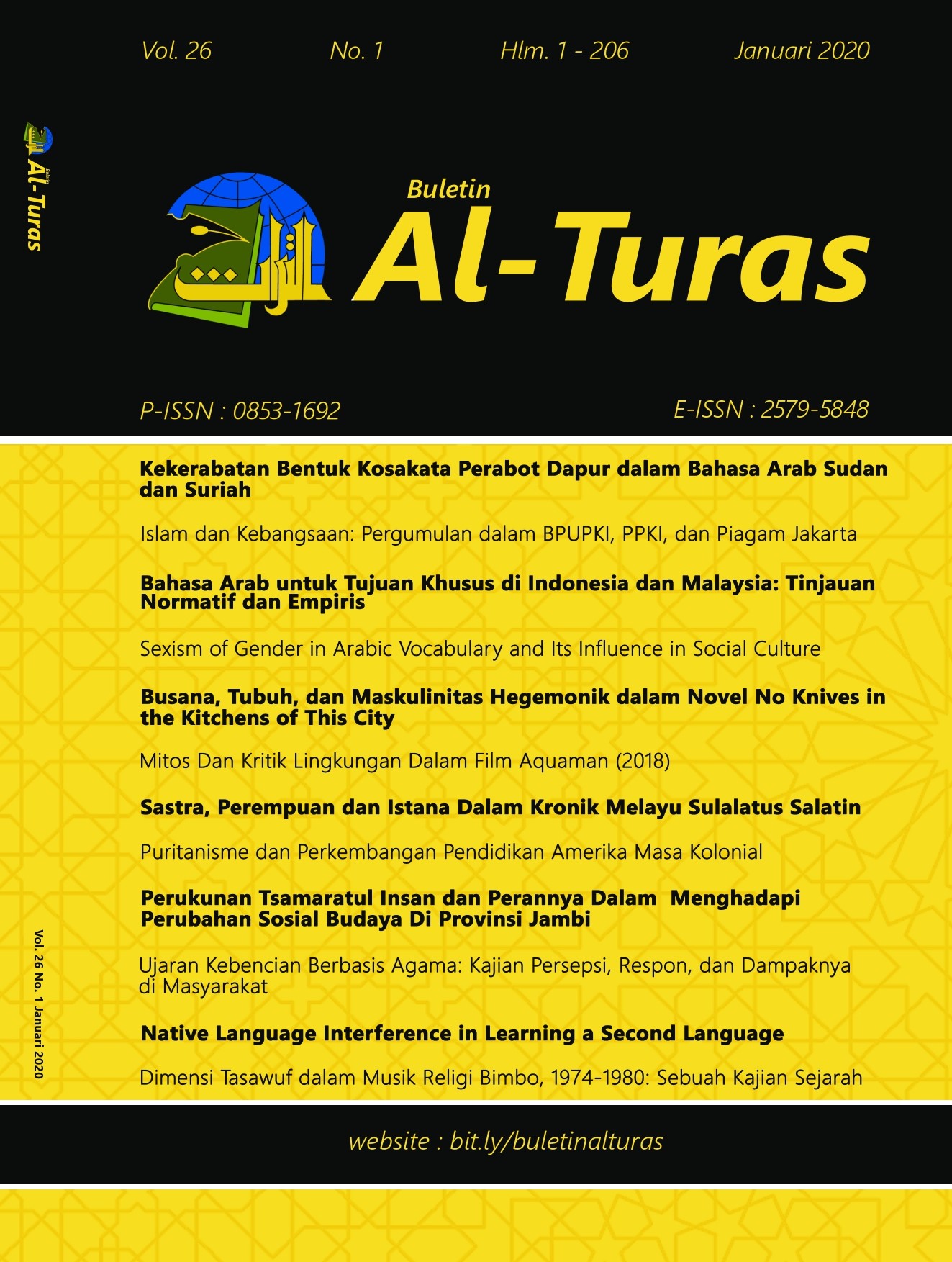Mitos dan Kritik Lingkungan dalam Film Aquaman (2018)
DOI:
https://doi.org/10.15408/bat.v26i1.14452Keywords:
myth, environmental ethical perspective, ecocriticism, movie analysisAbstract
Aquaman is a superhero movie that presents the environmental issue through the conflict between human and nature in the middle of the dispute for the throne as the ocean master. The movie also myth related to ocean. This article aims to describe how the movie presents the human-nature relationship. Besides, it also aims to analyze how the myth plays role in improving human-nature relationship. This research uses descriptive qualitative method, ecocriticism approach, and Sonny Keraf’s environmental ethical perspective. The result shows the relationship between human and natures that presented in the movie are not harmonious. This unharmonious relationship is shown through the conflict betwen the character of Arthur and Orm, whose each is the representation of human and nature. The research also finds that the myth about the trident influences the formation of environmental ethical perspective. Thus, myth plays an important role in improving the human-nature relationship in order to create an ecological balance.
Penelitian ini bertujuan untuk mengungkapkan hubungan antara lingkungan dengan manusia yang dihadirkan di dalam film Aquaman. Aquaman adalah film superhero yang menghadirkan hubungan problematik antara manusia dan lingkungan di tengah kisah perebutan tahta kerajaan laut. Film ini juga menyajikan mitos yang berhubungan dengan laut sebagai bagian dalam hubungan manusia dan lingkungan. Penelitian ini juga mengkaji bagaimana mitos berperan memperbaiki ketidakharmonisan hubungan antara manusia dan lingkungan. Penelitian ini menggunakan metode deskriptif kualitatif dengan pendekatan ekokritik dan perspektif etika lingkungan Sony Keraf. Hasil dari penelitian ini menunjukkan bahwa hubungan antara alam dengan manusia di dalam film digambarkan tidak harmonis. Hubungan tidak harmonis hadir melalui konflik yang terjadi antara tokoh Arthur dan Orm, yang masing-masing mewakili manusia dan alam. Penelitian ini juga menemukan bahwa mitos mengenai trisula berperan penting dalam membentuk perspektif etik lingkungan yang dihadirkan melalui tokoh Arthur. Dengan demikian, dapat disimpulkan bahwa mitos sangat berperan di dalam memperbaiki hubungan antara alam dan manusia demi menciptakan adanya keseimbangan lingkungan.
تهدف هذه الدراسة إلى الكشف عن العلاقة بين البيئة والبشر في فيلم .Aquaman Aquaman هو فيلم خارق يقدم علاقة إشكالية بين البشر والبيئة في منتصف الصراع على عرش مملكة البحر. و يعرض الفيلم أيضًا الأساطير المتعلقة بالبحر كجزء من العلاقات الإنسانية والبيئة. و تتناول هذه الدراسة كيف تساهم الأساطير في تحسين تنافر العلاقة بين البشرو البيئة أيضا. هذه الدراسة تستخدم طريقة وصفية نوعية مع المدخل إيكوكريتيك (Ekokritik) و على ضوء الأخلاق البيئية لسوني كراف (Sony Keraf). و تشير نتائج هذه الدراسة إلى أن العلاقة بين الطبيعة والبشر في الفيلم توصف بأنها غير متناغمة. و العلاقات المتناغمة موجودة من خلال النزاعات التي تحدث بين شخصيات آرثر(Arthur) وأورم (Orm)،كلاهما يمثلان البشر و الطبيعة. و للأسطور حول تريسولا (trislua) دور مهم في تشكيل الأخلاقي البيئي الذي قدمه آرثر(Arthur). لذلك، استنتج الباحث أن للأسطور دورًا مهمًا في تحسين العلاقات بين الطبيعية و البشر من أجل التوازن البيئي.
References
Abraham, O., & Abdulmalik, A. (2015). Ecocritical Analysis of Myth in Achebe’s Things Fall Apart. IOSR Journal Of Humanities And Social Science Ver. II, 20(6), 46–50. https://doi.org/10.9790/0837-20624650
Allen, M., & Pisani, C. (2018). Technology can either save or destroy nature. https://www.swissinfo.ch/eng/marco-lambertini_-technology-can-either-save-or-destroy-nature-/43848866
Beer, R. (1999). The encyclopedia of Tibetan symbols and motifs. Shambala; Distributed in the United States by Random House.
Bracke, A., & Corporaal, M. (2010). Ecocriticism and English Studies: An Introduction. Routledge, 9(September 2014), 37–41. https://doi.org/10.1080/0013838X.2010.518038
Buell, L., Heise, U. K., & Thornbern, K. (2011). Literature and Environment. Annual Review of Environment and Resources, 36, 417–440. https://doi.org/10.1146/annurev-environ-111109-144855
Cartwright, M. (2016, April 8). Atlantis. Ancient History Encyclopedia. https://www.ancient.eu/atlantis/
Choudhary, M. P., Chauhan, G. S., & Kushwah, Y. K. (2015). Environmental degradation: causes, impacts, and mitigation. National Seminar on Recent Advancements in Protection of Environment and Its Management Issues.
Cohen, M. P. (2014). Blues in the Green: Ecocriticism under Critique. Environmental History, 9(1), 9–36. https://doi.org/https://doi.org/10.2307/3985943
Coupe, L. (2000). Bate & Leavis: an Ecocritical Connection? Green Letters, 2(1), 13–19. https://doi.org/10.1080/14688417.2000.10588968
Garrard, G. (2004). Ecocriticism. Routledge.
Keraf, A. S. (2010). Etika lingkungan hidup. Penerbit Buku Kompas.
Moe. (n.d.). Symbol of the Trident | Gnostic Warrior. Retrieved December 14, 2019, from https://gnosticwarrior.com/trident.html
Purnama, Lembah, G., & Yunidar. (2019). Ethnic Mythology of Kaili in Palu: An Ecocritic Study. Proceedings of the 28th International Conference on Literature: “Literature as a Source of Wisdom,” 11–13, 721–731. https://doi.org/10.24815/.v1i1.14533
Sukmawan, S. (n.d.). Model-Model Kajian Ekokritik Sastra. 2008.
Sulistijani, E. (2018). Kearifan Lokal dalam Kumpulan Puisi Kidung CisadaneKarya Rini Intama (Kajian Ekokritik Sastra). NUSA, 13(1), 1–14.
Up, A., & Devarani, B. (2018). Dynamics of Ecocriticism. International Journal of Academic Research and Development, 3(2), 1383–1385.
Wilkinson, P. & N. P. (2007). E YE WITNESS companions.
Zekavat, M. (2014a). Ecocriticism and Persian and Greek Myths about the Origin of Fire. CLCWeb: Comparative Literature and Culture, 16(4). https://doi.org/https://doi.org/10.7771/1481-4374.2615
Zekavat, M. (2014b). Ecocriticism and Persian and Greek Myths about the Origin of Fire. CLCWeb: Comparative Literature and Culture, 16(4). https://doi.org/https://doi.org/10.7771/1481-4374.2615







